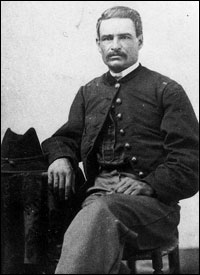Stephen Atkins Swails facts for kids
Quick facts for kids
Stephen A. Swails
|
|
|---|---|

1st LT. Stephen Swails, 1864
|
|
| Born | February 23, 1832 Columbia, Pennsylvania |
| Died | May 17, 1900 (aged 68) Kingstree, South Carolina |
| Place of burial | |
| Allegiance | |
| Years of service | 1863–1865 |
| Rank | |
| Battles/wars | American Civil War |
Stephen Atkins Swails (born February 23, 1832 – died May 17, 1900) was a brave soldier who fought for the Union Army during the American Civil War. He made history as the first African-American soldier to become a commissioned officer in the Union Army. This means he was promoted to a leadership role, even though the U.S. War Department first said no because of his "African descent."
Stephen Swails was a free African American man. He worked as a waiter and boatman before joining the army. In 1863, he heard Frederick Douglass's call for African Americans to join the fight. Swails then joined the famous 54th Massachusetts regiment. He served with them until the war ended. After the war, he moved to South Carolina and later Washington, D.C.. He became a successful lawyer and politician.
Contents
Serving in the Civil War
Stephen Swails joined the 54th Massachusetts regiment on April 23, 1863. He quickly showed his leadership skills. He was soon made the company's first sergeant. Because many soldiers were lost in a battle at Fort Wagner, Swails was promoted again. He became the acting sergeant-major of the 54th on November 12, 1863.
Bravery at Olustee
In early 1864, Swails' regiment was sent to Florida. On February 20, he was wounded in the head during the Battle of Olustee. He fell unconscious on the road but was saved by an officer from his regiment. After this battle, his commander, Colonel Edward Hallowell, wanted to recognize Swails' bravery. He asked the governor to make Swails an officer.
Fighting for His Rank
On March 26, 1864, Governor Andrew approved Swails' promotion to second lieutenant. But the War Department refused to make it official. They said it was because of "Lieutenant Swails' African descent." Colonel William Gurney ordered Swails to take off his officer's uniform.
However, Colonel Hallowell and Governor Andrew fought hard for Swails. Swails even traveled to Washington, D.C., to present his own case. Finally, on January 17, 1865, the War Department agreed. Stephen Swails was officially made a second lieutenant. This ended almost a year of struggle for his promotion. During this time, Swails continued to act as an officer and fought in many battles.
Second Wound and Promotion
On April 11, 1865, near Camden, South Carolina, Lieutenant Swails was wounded a second time. He was leading a group to capture some trains. As he entered a train, he waved his hat in victory. Sharpshooters, who thought he was a white engineer, fired at him by mistake.
Second Lieutenant Swails was promoted to first lieutenant on April 28, 1865. He left the army on August 20, 1865, when his regiment was officially finished.
Life After the War
After the war, Swails worked for the Freedmen's Bureau. This organization helped formerly enslaved people. He also became a lawyer in the South. He was very active in politics in South Carolina. He married Susan Aspinall and had three children with her. He also had children from a previous relationship.
Political Career
Stephen Swails served as the mayor of Kingstree from 1868 to 1879. He was also a state senator for ten years (1868–1878). For three of those years, he was the president pro tem, a high leadership role in the state senate.
Swails was a delegate to the Republican national conventions in 1868, 1872, and 1876. He also became a member of the U.S. Electoral College. This group formally elects the President and Vice President of the United States. He also edited a newspaper called the Williamsburg Republican.
After the period known as Reconstruction, Swails was forced to leave politics. A white mob even tried to assassinate him. He then resigned from his political roles. Thanks to his connections, he got jobs in Washington, D.C. He worked for the U.S. Postal Service and the United States Treasury Department.
Stephen Swails is buried in the Friendly Society Cemetery in Charleston, South Carolina.
Family Life
Stephen Swails had many descendants. They live in places like Toronto, New York, Philadelphia, and Atlanta. His grandson, James Swails Sr., passed away in 2004. His granddaughter, Carolyn Janet Rollins, and another grandson, Robert Swails, are also deceased. Dr. Robert Swails Rollins was a medical doctor and a flight surgeon in the United States Air Force.

